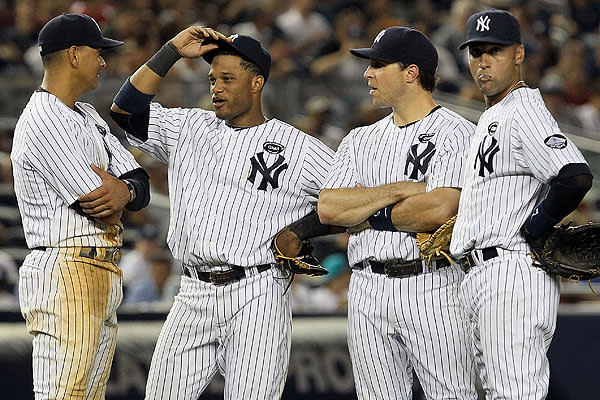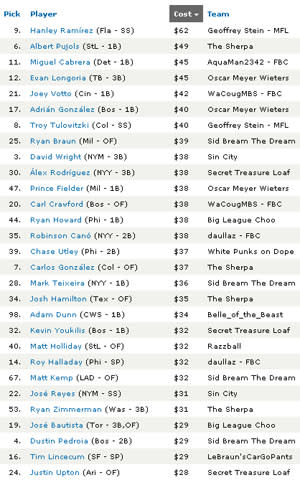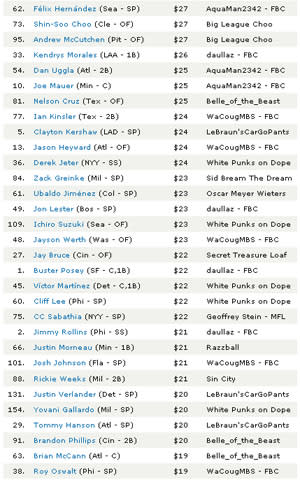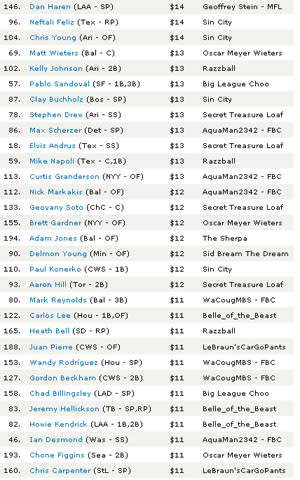The Roto Arcade Pro-Am, Year Three
The first thing you need to know about the 2011 Roto Arcade Baseball Pro-Am is that the auction actually took place a long time ago. Not merely days ago, but weeks. Maybe longer.
Back when we originally held this auction, I'm fairly sure that Chase Utley had two functional knees. And Larry Walker was an Expo. And Ron Gant may have been my first nomination, because that's what Hector and Victor told me to do. If I recall correctly, I actually wrote the first commissioner's report for this league on WordPerfect 5.1, then printed off 14 copies.
So the point is, when you read the Q&A below (if you choose to do so), please realize that all of the responses were written a couple weeks back, in what now feels like a different fantasy era. A simpler time. You might have to adjust the prices for inflation. More than 50 transactions have taken place in this league since we held the auction, so things have changed a bit. Still, it only seems right to publish comments from league participants, since this Q&A stuff is a deadly serious endeavor.
You can find full auction results right here. Let's turn back the clock…
Geoffrey Stein, My Fantasy League
Q: So you spent a total of $102 on Hanley Ramirez and Troy Tulowitzki. Going in, I assume your plan was to land the two elite options at an otherwise messy position, yes?
A: I've ended up with Juan Uribe as my starting shortstop in way too many of my early leagues, so I know how thin the position is entering the 2011 season. As a result, my plan going in was to land Hanley Ramirez and Troy Tulowitzki at any cost to make sure I remained Uribe-less and hopefully drive up the price on some of the more mediocre shortstop options. Paying $62 for Ramirez was far from ideal, but I was determined to stick to the strategy. I'm interested to see how it works out.
Q: You walked away with two of my favorite end-of-draft options, Bud Norris and Kila Ka'aihue. Please give us a projection for those two.
A: Bud Norris quietly had more strikeouts (158) than innings pitched (153.2) last season, so he's obviously doing something right. With a 4.92 ERA and 1.48 WHIP, he's doing something wrong, as well. I think he'll have plenty of ups and downs in his second full season as a major leaguer, but should put things together enough to be a decent No. 5 starter. I'm optimistically predicting at least 170 strikeouts, an ERA in the low-4s and a WHIP that won't do too much damage to my team.
When Kila Ka'aihue got playing time last September, he made the most out of his 84 at-bats with a .274 average, six homers, 16 RBI and a .908 OPS. Add that to his success in the minors, and it's hard not to take a gamble on the slugging Hawaiian at the end of auctions/drafts. Seeing that the Royals are the Royals, I'm worried that Ka'aihue may get the hook early if he struggles, but I am currently penciling him in for 20-plus longballs and a decent amount of RBI.
Fitzy, Roto Arcade commenting treasure
Team name: Belle of the Beast
Q: It appears you've assembled a mix of bounce-back candidates (Zobrist, Ramirez, Lee, Quentin) and players that Brad Evans loves (Cruz, Stubbs, Walden). Does that pretty much sum up your approach to fantasy baseball?
No, seriously, give me projections for the bounce-back players, particularly Aramis and Lee. Those two are causing headaches for many owners.
A: The thing I like about bounce-back candidates is it potentially allows you the opportunity to make a profit amongst a group of savvy, experienced drafters. Fantasy baseball buffs — of which I'd certainly classify this motley crew (or Mötley Crüe, if you're a fan of the metal umlaut — and who isn't?) of Roto Arcaders — tend to gravitate towards the "new," the guys on the verge of possible super-stardom. I think I get it — sometimes to truly exert your knowledge dominance in a H2H league, it's not enough to beat an opposing manager with Hanley Ramirez, it's about beating them with a shortstop they've barely even heard of.
I'm certainly not immune to this kind of thinking, but I think it can lead to undervaluing players that had an "off" season due to injury, intangibles, or just plain bad luck. So how does one differentiate an off season from natural regression, or even a downward career arc? The truest answer to this question, of course, is that one never truly knows, but I like to look at BABIP (for "luckiness"), pre/post AS game splits (did said player finish the year strongly or weakly?) and, most importantly, actually watching as many games/video as possible (watching live action ALWAYS trumps sorting through numbers). Speaking of which, my team is littered with players that ranked in the bottom 10 for BABIP last year — Lee, Ramirez, Quentin, Uribe. This actually wasn't any sort of intentional plan on my part, I just think I have a natural tendency to gravitate towards buying on the bear market.
I don't really do specific projections, but to give you a really brief overview of why I picked certain ballers in question: Zobrist — liked his value as a 2B and his positional flexibility; Ramirez — second half of '10 right in line with his career ratios; Cruz and Stubbs — high-ceiling candidates that you only have to pay a "floor price" to acquire (my only concern for both, for different reasons, is playing time). It's very possible that I overpaid slightly for the services of Lee (who is admittedly probably more of a "hold steady" guy than a bounce-back one) at $11 — especially when I look at Vlad for $8 — but at that point in the draft I was desperately seeking an OF starter and a 1B backup, and he filled both of those needs.
Now that you've mentioned Brad in that context, however, I'm rethinking my entire auction.
Jared Norris, Rotowire
Sid Bream the Dream
Q: OK, auto-drafter, how were you feeling about the roster, post-auction? What's the greatest area of need, and what have you done to address it?
A: It is true. I committed the deadly sin of fantasy sports and auto-drafted. I have always been on the other side of the fence, the one ridiculing the managers who bought third-string catchers for two dollars, and so far it has definitely been a struggle dealing with the hand I was dealt.
Come to think about it, auto-drafting a team is kind of like experiencing one of those awful Christmases each child inevitably faced once in their life — the Christmas in which you spent weeks with your crayons filling out your wish list (player rankings) for Santa (Andy Behrens), even going as far as ranking your presents in order.
Then you wake up Christmas morning (night after draft) and tear off the wrapping paper with excitement…which then becomes utter confusion, disappointment, and downright sadness when you find you've got:
1. Socks - Yuniesky Betancourt
2. Malfunctioning Nintendo game - Adam Wainwright
3. Miata Micro Machine - David DeJesus
4. Bird feeder - Ty Wiggington
5. Rolly backpack - Rod Barajas
6. Another bird feeder - Darren O'Day
To be fair, I did come away with some items off my wish list: Zach Greinke, Ryan Braun, Matt Kemp, David Price and Pedro Alvarez.
My greatest area of need is definitely up the middle. I was left with Miguel Olivo and Rod Barajas at catcher, Yuniesky Betancourt and Freddy Sanchez at SS and MI. I was also left with one closer, Carlos Marmol. Since the draft I have been busy on the waiver wire ,grabbing Nick Hundley, Cliff Pennington and rounding out my staff with J.A. Happ, Jeff Niemann, Alexi Ogando and Marc Rzepcynski. I missed out on a waiver request for J.J. Hardy, which hurt.
Q: I'd be happy to take Zack Greinke off your hands. What gets a deal done? If you're looking for Uptons, I got 'em…
A: Was Greinke feeling he needed to prove something in a game of H-O-R-S-E? I'm still pretty high on him even though he will likely start 5-6 fewer games than I was banking on. Send me a Geovany Soto and a Christmas present this year and we have a deal.
Million Dollar Sleeper
Big League Choo
Q: Awesome team name. I prefer when fantasy managers name teams after players they actually own, so well done. But…somehow you've ended up with Callaspo, Arthur Rhodes, Hanigan, Yunel. Where and how did it all go horribly, horribly wrong?
A: Callaspo is just keeping the seat warm for Jose Lopez. Once Lopez regains his lost eligibility at 2B, I'll have a cheap source of 20 homers at my MI slot. Eric Young Jr. has a fracture in his leg (the reason he wasn't dealt to Texas) and Ian Stewart can't hit lefties (a Lopez specialty), so I'm not worried about playing time. I have no defense for Ryan Hanigan, other than the fact he keeps the strikeouts minimal, hits a ton of line drives and takes plenty of walks. I'm hoping for a Ramon Hernandez injury here. At least I have the approval of Brad Evans. That's good…right? Yunel Escobar will be a top-12 shortstop once again. The skill set is still there, I'm not putting any value in a bad luck BABIP and HR/FB rate. Yunel should bat second between Rajai Davis and Jose Bautista, so I have high expectations. He makes for a great late-round option for anyone who doesn't land Hanley or Tulowitzki, and refuses to overpay for the leftover trash at the position.
Q: You're carrying one closer, plus Rhodes (who I assume is some sort of bullpen coach, and not a real member of your squad. Like Virgil, maybe). What's your saves strategy? Chris Perez alone will almost never win you the category. Are you planning to add another source of saves from the free agent pool, or are you shopping Perez?
A: Well, let's just say a man of my tastes tends to run out of money faster than others in auction leagues. I failed to save enough cash for a second closer, and nobody was willing to lend me a few bucks in exchange for Virgil's services. Lucky for me, this is a head-to-head league so I don't need a second or third closer until the playoffs start. Plus A-Mak's off-the-wall strategy prevented some teams from owning more than one source of saves. I count close to five other teams who are in the same boat as me. If I can beat the Razzball boys to the wire, that'd be great, but I'm not counting on it. Some sort of trade is likely to happen; whether I deal for a closer or send Perez packing depends on the market.
Maybe it was foolish of me to predict what Ron Washington would do, but I think most MLB coaches would side with the experienced eighth inning man when choosing Neftali's successor. It worked for me when I backed Ryan Franklin over Jason Motte. If Washington isn't a pupil in the La Russa school of thought, Arthur "The American Dream" Rhodes will be dropped in favor of a longshot closer or a starting pitcher who has a two-start week or a zesty match-up. It's always nice to have a rotating roster spot. In a nutshell, I'm hoping for a decent trade offer or some luck via the wire.
Ed. note: In the end, obviously Ron Washington & Co. decided to keep Neftali in the ninth. And MDS has made eight transactions.
Q: Bautista was an interesting buy, and you got him a the right price. He was un-ownable one year, unbelievable the next. What's the official MDS forecast for Bautista in 2011? (Or is that for subscribers only?)
A: I am a big believer in the adjustments Bautista made at the plate (detailed here). The power numbers were consistent last season, this wasn't a one or two-month binge. The official MDS forecast calls for a .257 Batting Average with 43 HR, 99 Runs, 109 RBI and 6 SB in 565 At Bats. This includes a 20.7 K percentage, 18.6 HR/FB and .252 BABIP.
Scott Swanay, Fantasy Baseball Sherpa
The Sherpa
Q: I've always enjoyed your nomination strategies, Scott. In the Pro-Am, you tossed out a few $1 catchers, ending up with three of them. Were those players specifically targeted? Or were you thinking/hoping someone would go to $2 on any of them? What's your general philosophy on filling that spot in a two-catcher league?
A: I'm always trying out different strategies for roster composition, auction budgets, and player nominations to get a better feel for what works and what doesn't. Everyone in a league like this knows all the players well, so you're not going to sneak anybody through the way you might in a less competitive league.
With $260 auction budgets, most owners don't stray too far from the $180/$80 Hitter/Pitcher split. In an expert league if you stray too far from the $180/$80 rule, the results won't be pretty.
That leaves nominating strategy as the primary means available to be a warlock among trolls. Nominating strategy is equal parts psychology, economics, and game theory. In this particular auction, with 14 teams, I nominated inexpensive catchers for a couple of reasons: 1) people are more likely to pass on inexpensive players earlier in an auction; 2) taking inexpensive players off the board first tends to make remaining players at that position more expensive than they would be otherwise.
Q: The highest you went on any starting pitcher was $7. Too much risk attached to the position for you, or were you simply targeting a few guys after the usual mid-auction price adjustment?
A: I was buying $7 pitchers because that's how I roll. I rarely spend more than $30 on a player, but because I thought a number of star players were undervalued, I bought four $30+ players for a total of $152. Throw in a pair of $14 closers, and I had less than $4 per player left to fill out my 21 remaining roster spots. The $7 cap on starting pitcher bids was part of my impromptu plan to avoid getting into bidding wars over the likes of Paul Janish and Alex Sanabia. All things considered, I'm very happy with the starting pitchers I was able to purchase with such a limited budget. It's all about winning!
Steven Lorenz, Fantasy Cafe
AquaMan2342 - FBC
Q: You've got a few reclamation projects on your roster: Gordon, Quentin, Encarnacion, Granderson, et al. Was that a strategy entering the auction, targeting the post-hypes and/or players coming off disappointing seasons?
A: I suppose it was a strategy to target players in that mold, but it still had to be at the right price. A lot of it was about timing, too. Towards the middle of the draft, the prices were falling and I figured it was as good a time to strike, considering I waited a while to purchase my first outfielder. I was fortunate to see others nominate some of the players I was targeting (Markakis, Rios) while being able to nab Granderson and Quentin (later traded for Zobrist) at good prices.
Q: No closers on your roster, but three excellent set-up men. What's the plan? Win the ratios and punt saves? Or do you think you've got a couple future closers there?
A: I'd consider it a flexible strategy. I definitely wasn't going to go after just any handcuff option, and figured worst-case scenario they can help my ratios and even boost my K numbers a bit each week. If they end up closing, more power to me. But I wasn't really interested in paying what seemed to be inflated prices for guys like Hanrahan or Francisco just to compete for saves. For a position with so much turnover, I have no problem scouring the wire throughout the season.
Rudy Gamble and Grey Albright, Razzball
Q: Your lineup is loaded with sophomore hitters and sophomore pitchers: Castro, Walker, Stanton, Tabata, Hudson, Storen, Axford, Chacin. Most experts like these guys well enough, but you're obviously bullish enough to buy. Were any of these players specifically targeted? Were you thinking you'd end up with so many year-two players? Among that group above, which players worry you most as slump candidates?
A: With all the PED testing in place to help old players, we didn't want to take a chance on any player over 25 and rookies are too risky … actually, we didn't target sophomores, but we did really like Mike Stanton and Daniel Hudson coming into the draft. We just liked the price on the rest of them. Neil Walker and Jhoulys Chacin are the most concerning slump candidates — perhaps Walker the most, since we have to play him at 3B because we punted the position.
Q: There are no $1 players on this team, and only two guys who went for $20 or more. Safe to assume that this was by design? It's not the approach everyone takes in mixed league auctions, where stars-and-scrubs often rules the day.
A: We really wanted a deep pitching staff that we could leverage for match-ups, and a lineup that was strong on R/HR/RBI. We did splurge on Holliday at $32 and Morneau at $21, but, otherwise, we felt the bidding was too rich for top hitters/pitchers. We had 14 guys at $30+ and only Pujols above $40, whereas 25 players went for $30+ and 7 at $40+. A 14-team league is deep enough that we knew we could build a strong team with the remaining players.
A-mak15, Roto Arcade commenter of distinction
LeBraun'sCarGoPants
Q: You're a weasel. Let's just throw that out there, then proceed to question No. 2…
Q: My assumption is that you're going with a classic Distler strategy here, playing for the 6-4 win. Dominant pitching staff, speedy hitters. Is that the case? And if so, are you concerned that it might be tougher to pull off in a weekly lineup league?
A: I fully expected the questions for a-mak15 to look like this: 1) What were you drinking, in-auction? 2) How many of those did you down? I mean, you know your lineup is unreasonably bad, when Brian Roberts nearly wins the Triple Crown for your offense in 2009.
My entire outfield cost $1 less than Jose Bautista. But this was by design. This is the Distler method, revised. (It's funny, in his second post, I was soundly opposed to the notion that a strategy like this would even work).
I didn't want to punt three categories outright — runs, home runs and RBIs — and, for the most part, neglect batting average. You see, Distler would abstain from drafting catchers and first basemen. Too dicey in this league. So I filled my roster.
I developed multiple strategies, one of which included punting batting average by coming away with Pena, Reynolds and Dunn, then burners Bourn, Pierre and Davis — affordable, plus an average line of 79/17/69/31 — but Distler's method made the most sense in this format. (Speed is economical and pitchers are commonly undervalued in auctions, and everyone's looking to go 180/80). With weekly lineup changes, managers can't stream to beat me in Ws and Ks, and they can't bench their rotation when they've won ERA and WHIP mid-week.
This approach also allowed me to manipulate the noms. I would withhold from bidding on emerging position players and trendy starters, so I studied managers' drafting habits, and from their blogs, tweets and Facebook postings, I constructed a list of everyone's favorite targets. My nominations, in order, went like this: Heyward (sold for $24), Bruce ($22), Carlos Santana ($19), Stanton ($19), Wieters ($13), Hellickson ($11), Morrow ($15), Storen ($7), Marcum ($14) and Volquez ($7). All went for market value or above; everyone still had funds early, no discounts. When you're drafting against a room full of knowledgeable and skilled roto players, there are no sleepers. Pony up.
On average, I put in four hours of prep time per league. Last season I crammed six hours before the auction and finished the draft blinking uncontrollably. This year I clocked in at eight hours, five minutes and twenty-one seconds. I was thoroughly prepared. The first two seasons I came in timid, deer-in-headlights. This year I came in with Anderson Silva swagger, Mayweather moxie. I'm going for my third title in a row. Though there's a good chance this strategy fails miserably I come out looking like a turkey.
Q: Yeah, I should probably also mention that you are, if I recall correctly, the defending champ. And you streamed like a [profane] last year.
A: Do you know who I am?. (Sorry, like Miggy, I'm lousy at icebreakers. That probably didn't win me any supporters). "Defending," as in I've won this imaginary belt twice. Yes, I've bi-won. Again, not garnering sympathy votes. I shouldn't run for an election of any sort. I'd lose decisively.
Eric Hinz
Oscar Meyer Wieters
Q: First of all, congratulations on finally landing Matt Wieters in this league. He's been part of your team's name since 2009, but never part of your team's lineup until now. Is this the year he actually breaks out, or will it just be another season of ordinary stats at a better price?
A: Being No. 2 stinks. Adding the eponymous catcher should end that! For the price, Weiters is nearly risk-less. A 15/60/.260 season appears to be the floor. Let's hope its isn't also the ceiling.
Q: You filled 2B, SS and MI for a total of $14. Entering the auction, were you planning to avoid the bidding wars on the elite middle infielders? What are you projecting for Reid Brignac in 2011?
A: I decided to spent on absolute corner power, rather than chase relative power in the middle — especially amongst the three elite middle infielders (Cano, Hanley, Tulo). Reid Brignac is going to be a Kelly Johnson type — low mixed league cost, all upside return — but as a 2B/SS-eligible player. Let's hope all the Tampa Bay Kool-Aid drinkers are right, and the Rays barely notice the loss of two Gold Glove caliber players, a bullpen and a solid No. 3.
Scott Pianowski
Q: It appears you executed the stars-and-Phillies strategy flawlessly. Nicely played. But you may have picked the wrong year to go $37 on Utley. What's your back-up plan, if we have a worst-case knee scenario? Are you going to Polanco, just like the Phils may have to?
(Note: I'm composing this question two weeks after the auction. Utley was everyone's second-ranked 2B when teams were assembled).
A: Shortstop is the thin position, but second base isn't so bad. I've scooped up Bill Hall for depth, for a few reasons. He's a two-position player, he's got power and speed, and he's motivated from last summer when Peter King couldn't stop bashing him. Utley comes with assumed risk. I won't cry over him.
Q: Are you satisfied with how well you followed your Tip Drill recommendations in this auction? It seems like you purchased a few of your pet players — Jeter, V-Mart, Westbrook, Murphy, Papelbon — and you were able to go the extra buck on a few useful players.
A: I didn't build my team the way I normally would. I don't like to buy a designer catcher, but Victor Martinez at $22 made sense to me. I did like the affordable prices on the top of my staff (Cliff Lee, Yovani Gallardo, Jered Weaver). But I didn't get a third closer — A-mak had money and wanted the deepest bullpen in fantasy history — and my second and third-tier pitchers aren't very impressive. It's going to be a ham-and-egg season.
Q: Is there enough power on your team? Shouldn't you make me a blockbuster trade offer for A-Rod?
A: I never seem to have enough power. My teams try to Victorino you to death. Sometimes it works, sometimes it doesn't. I better find this year's Bautista. (Of course there's not going to be a 54-homer freebie. Those things don't repeat).
RJ White, Fantasy Cafe
daullaz - FBC
Q: If this were a real team, your training staff would be overworked. You've got Grady Sizemore, Kendry Morales, and Jake Peavy on the roster. What's your forecast for those guys? Is it safe to assume you saw value in guys coming back from injury?
A: Of the three, the only one I'm really concerned about is Sizemore. I panicked a bit when I didn't have an OF and overspent on him thinking only about his tremendous upside, but I'd give him a relatively small chance of making good on that upside. Still, if Sizemore failing to make good on a $9 auction price is the worst thing that happens to me this year, I'll take it. I overpaid a bit for Morales, but his injury doesn't worry me in the slightest, and I made up on the price of Morales by finding a few bargains later. I absolutely love cashing in on Peavy at a $2 price. His rehab has gone well, and it's not often you can get a youngish former ace at an end-game price.
Joshua Collins, Fantasy Sports MVP
Sin City
Q: I see you've handcuffed Neftali with Mark Lowe, just in case. Nice. That's one of seven transactions you've made so far. Are you typically this active before opening day? Any method to the transactional madness?
A: Yes, but I've been far more active in our league, given the settings. Because we use weekly transactions, not daily, the way I'm approaching my final bench slots is very different than I normally would. So, yes, there is a method to the transactional madness.
Since I only need to replace my hitters if one of them gets injured, there's no need for multi-positional back-ups. My plan is to allow one bench slot for whoever might be hot in the free agent pool at the time (as a possible Util/P play), and one bench slot for adding two-start pitchers with favorable match-ups.
That leaves me two bench spots that I don't need to use right away, and one bench spot that I essentially have no "real" need for. So, why not spend the pre-season picking up any players I feel might have an outside chance to provide an immediate impact? If nothing comes of it or they don't break camp, who cares? I can just toss them back for more immediately useful players once the season starts.
Q: You've stashed Brandon Belt, a buzzy prospect. What are your hopes for him? Give me an ETA on Belt, please. At the rate you're adding and dropping, it seems kinda unlikely you'll hold the kid until he's called up, assuming he doesn't open the season in San Francisco.
A: I've just had a feeling for a while that he would break camp. (Ed. note: And that turned out to be the correct feeling. Well-played, sir). If he keeps having days where he puts up three runs and three hits, I think he has a outside shot.
I won't hold Belt AND Moustakas once the season begins, so you're correct in your thinking that he may be released then. There are plenty of speculative RP additions that would make more sense for my team to hold on to right now.








